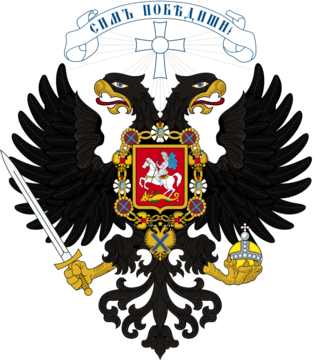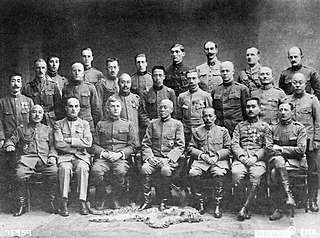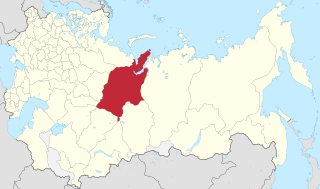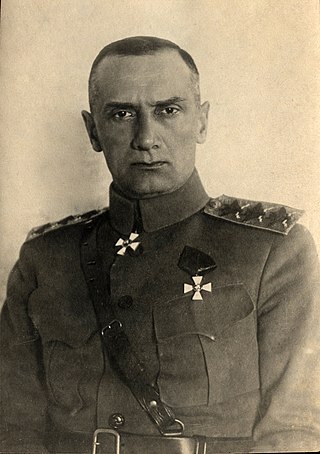
The Russian Civil War was a multi-party civil war in the former Russian Empire sparked by the overthrowing of the social-democratic Russian Provisional Government in the October Revolution, as many factions vied to determine Russia's political future. It resulted in the formation of the Russian Socialist Federative Soviet Republic and later the Union of Soviet Socialist Republics in most of its territory. Its finale marked the end of the Russian Revolution, which was one of the key events of the 20th century.

The Far Eastern Republic, sometimes called the Chita Republic, was a nominally independent state that existed from April 1920 to November 1922 in the easternmost part of the Russian Far East. Although nominally independent, it largely came under the control of the Russian Soviet Federative Socialist Republic (RSFSR), which envisaged it as a buffer state between the RSFSR and the territories occupied by Japan during the Russian Civil War of 1917–1922. Its first president was Alexander Krasnoshchyokov.

Sverdlovsk Oblast is a federal subject of Russia located in the Ural Federal District. Its administrative center is the city of Yekaterinburg, formerly known as Sverdlovsk. Its population is 4,268,998.

Yakov Mikhailovich Sverdlov was a Bolshevik Party administrator and chairman of the All-Russian Central Executive Committee from 1917 to 1919. He is sometimes regarded as the first head of state of the Soviet Union, although it was not established until 1922, three years after his death.

The Czechoslovak Legion were volunteer armed forces comprised predominantly of Czechs and Slovaks fighting on the side of the Entente powers during World War I and the White Army during the Russian Civil War until November 1919. Their goal was to win the support of the Allied Powers for the independence of Lands of the Bohemian Crown from the Austrian Empire and of Slovak territories from the Kingdom of Hungary, which were then part of the Austro-Hungarian Empire. With the help of émigré intellectuals and politicians such as the Czech Tomáš Garrigue Masaryk and the Slovak Milan Rastislav Štefánik, they grew into a force of over 100,000 strong.

The Provisional Siberian Government, was an ephemeral government for Siberia created by the White movement.

The White Army or White Guard, also referred to as the Whites or White Guardsmen, was a common collective name for the armed formations of the White movement and anti-Bolshevik governments during the Russian Civil War. They fought against the Red Army of Soviet Russia.

The Siberian intervention or Siberian expedition of 1918–1922 was the dispatch of troops of the Entente powers to the Russian Maritime Provinces as part of a larger effort by the western powers, Japan, and China to support White Russian forces and the Czechoslovak Legion against Soviet Russia and its allies during the Russian Civil War. The Imperial Japanese Army continued to occupy Siberia even after other Allied forces withdrew in 1920.

The Provisional All-Russian Government (PA-RG), informally known as The Directory, The Ufa Directory, or The Omsk Directory, was a short-lived government during the Russian Civil War, formed on 23 September 1918 at the State Conference in Ufa as a result of a forced and extremely unstable compromise of various anti-Communist forces in eastern Russia. It was dissolved two months later after the coup, which had brought Admiral Alexander Kolchak to power in Communist-free areas of eastern Russia.

Siberian regionalism is a political movement that advocates for the formation of an autonomous Siberian state. The idea originated in the mid-19th century and reached a high tide with the White movement military activities of Aleksandr Kolchak (1874–1920) and Viktor Pepelyayev (1885–1920) during the Russian Civil War of 1917–1922.

Tobolsk Governorate was an administrative division of the Russian Empire, Russian Republic and RSFSR located in the Ural Mountains and Siberia. It existed from 1796 to 1920; its seat was in the city of Tobolsk, in 1919–1920 in the city of Tyumen.

The revolt of the Czechoslovak Legion comprised the armed actions of the Czechoslovak Legion in the Russian Civil War against Bolshevik authorities, beginning in May 1918 and persisting through evacuation of the Legion from Siberia to Europe in 1920. The revolt, occurring in Volga, Ural, and Siberia regions along the Trans-Siberian Railway, was a reaction to a threat initiated by the Bolsheviks partly as a consequence of the Treaty of Brest-Litovsk. One major secondary consequence of victories by the Legion over the Bolsheviks was to catalyze anti-Bolshevik activity in Siberia, particularly of the Committee of Members of the Constituent Assembly, and to provide a major boost for the anti-Bolshevik or White forces, likely protracting the Russian Civil War.

The Siberian Army was an anti-Bolshevik army during the Russian Civil War, which fought from June 1918 – July 1919 in Siberia – Ural Region.

The Provisional Siberian Government was a short-lived government in Siberia created by the White movement in 1918.

Alexander Vasilyevich Kolchak was a Russian admiral, military leader and polar explorer who served as Supreme Ruler of Russia from 1918 to 1920 during the Russian Civil War. Previously, he served in the Imperial Russian Navy and fought in the Russo-Japanese War and World War I.

The Russian State was a White Army anti-Bolshevik state proclaimed by the Act of the Ufa State Conference of September 23, 1918, “On the formation of the all-Russian supreme power” in the name of “restoring state unity and independence of Russia” affected by the revolutionary events of 1917, the October Revolution and the signing of the treaty of Brest-Litovsk with Germany.
The State Conference in Ufa which took place on September 8–23, 1918, in the city of Ufa in southern Russia was the most representative forum of anti-Bolshevik governments, political parties, Cossack troops, and local governments of eastern Russia.

An index of articles related to the Russian Revolution and the Russian Civil War period (1905–1922). It covers articles on topics, events, and persons related to the revolutionary era, from the 1905 Russian Revolution until the end of the Russian Civil War. The See also section includes other lists related to Revolutionary Russia and the Soviet Union, including an index of articles about the Soviet Union (1922–1991) which is the next article in this series, and Bibliography of the Russian Revolution and Civil War.

Sergei Nikolaevich Rozanov was a lieutenant general, a leader of the White movement.

The Russian Government was the highest executive body in White-controlled parts of Russia during the Russian Civil War, formed as a result of the coup of 18 November 1918 in Omsk headed by Alexander Kolchak.


















